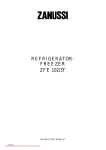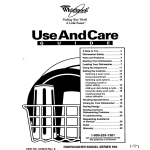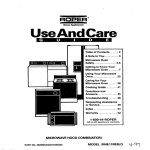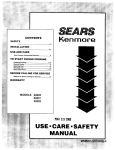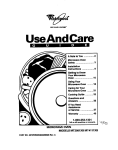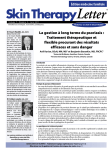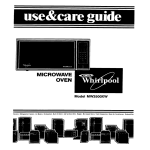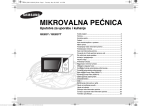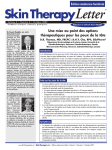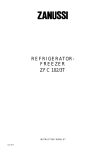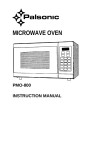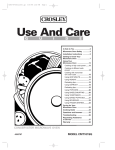Download Palsonic PMO-850 User's Manual
Transcript
lnstruction for use PMO-850 PMO-888 Table of Contents (complete) .................. 2 Microwave Oven Safety ......................... 3-4 Installation Instructions ................... 5 Getting to Know Your Microwave Oven ........... 7 Using Your Microwave Oven ......... 19 Caring for Your Microwave Oven ......... 34 Cooking Guide ............ 35 Questions and Answers ....................... 37 Troubleshooting .......... 38 Table of Contents Microwave Oven Safety............................ Important safety instructions ................... Precautions to avoid possible exposure to excessive microwave energy .............. Installation Instruction ............................. Getting to Know Your Microwave Oven ....................................... How your microwave oven works ........... For the best cooking results .................... Radio interference .................................. Testing your microwave oven ................. Testing your dinnerware or cookware ................................................ Operating safety precautions .................. Electrical connection ............................... Microwave oven features ........................ Control panel features ............................. Setting the clock ...................................... Using the minute time ............................. Using ADD MINUTE ............................... Using Your Microwave Oven ............... Cooking at high cook power ................ 3 3 4 5 7 7 9 9 9 10 10 12 13 14 16 17 18 19 19 Cooking at different cook powers.......... Cooking with more than one cook cycle ............................................ Using BAKED POTATOES .................. Using BEVERAGE ............................... Using POPCORN ................................ Using FROZEN ENTREE .................... Using DEFROST ................................. Defrosting tips ...................................... Using REHEAT .................................... Reheating tips ...................................... Using BREAKFAST ............................. Using VEGETABLES............................ Caring for Your Microwave Oven ......... Cooking Guide ....................................... Microwave cooking tips ..................... Questions and Answers ....................... Troubleshooting..................................... 2 20 22 24 26 27 28 29 30 31 32 32 33 34 35 35 37 33 Microwave Oven Safety Your safety and the safety of others is very important. We have provided many important safety messages in this manual and on your appliance. Always read and obey all safety messages. This is the safety alert symbol. This symbol alerts you to hazards that can kill or hurt you and others. All safety messages will be preceded by the safety alert symbol and the word “DANGER” or "WARNING". These words mean: You will be or seriously injured if you don't follow Instructions. You can be killed or serlously Injured If you don’t follow Instructions. All safety messages will identify the hazard, tell you how to reduce the chance of injury, and tell you what can happen if the instructions are not followed. IMPORTANT SAFETY INSTRUCTIONS When using electrical appliances basic safety precautions should be followed, including the following: WARNING: To reduce the risk of burns, electric shock, fire, injury to persons, or exposure to excessive microwave energy: Read all instructions before using the microwave oven. Read and follow the specific "PRECAUTIONS TO AVOID POSSIBLE EXPOSURE TO EXCESSIVE MICROWAVE ENERGY" found in this section. The microwave oven must be grounded. Connect only to properly grounded outlet. See "GROUNDING INSTRUCTIONS" found in the "Installation Instructions" section. Install or locate the microwave oven only in accordance with the provided Installation Instructions. Some products such as whole eggs in the shell and sealed containers for example, closed glass jars - may explode and should not be heated in the microwave oven. Use the microwave oven only for its intended use as described in this manual. Do not use corrosive chemicals or vapors in the microwave oven. This type of oven is specifically designed to heat, cook, or dry food. It is not designed for industrial or laboratory use. As with any appliance, close supervision is necessary when used by children. Do not operate the microwave oven if it has a damaged cord or plug, if it is not working properly, or if it has been damaged or dropped. The microwave oven should be serviced only by qualified service personnel. Call an authorized PALSONIC service company for examination, repair, or adjustment. Do not cover or block any openings on the microwave oven. 3 MICROWAVE OVEN SAFETY Do not store the microwave oven outdoors. Do not use the microwave oven near water - for example, near a kitchen sink, in a wet basement, or near a swimming pool, and the like. Do not immerse cord or plug in water. Keep cord away from heated surfaces. Do not let cord hang over edge of table or counter. See door surface cleaning instructions in the "Caring for Your Microwave Oven" section. To reduce the risk of fire in the oven cavity: - Do not overcook food. Carefully attend the microwave oven if paper, plastic, or other combustible materials are placed inside the oven to facilitate cooking. - Remove wire twist-ties from paper or plastic bags before placing bag in oven. - If materials inside the oven should ignite, keep oven door closed, turn oven off, and disconnect the power cord, or shut off power at the fuse or circuit breaker panel. - Do not use the cavity for storage purposes. Do not leave paper products, cooking utensils, or food in the cavity when not in use. - Do not mount over a sink. - Do not store anything directly on top of the microwave oven when the microwave oven is in operation. - SAVE THESE INSTRUCTIONS - PRECAUTIONS TO AVOID POSSIBLE EXPOSURE TO EXCESSIVE MICROWAVE ENERGY... (a) Do not attempt to operate this oven with the door open since open-door operation can result in harmful exposure to microwave energy. It is important not to defeat or tamper with the safety interlocks. (b) Do not place any object between the oven front face and the door or allow soil or cleaner residue to accumulate on sealing surfaces. (c) Do not operate the oven if it is damaged. It is particularly important that the oven door close properly and that there is no damage to the: (1) Door (bent), (2) Hinges and latches (broken or loosened), (3) Door seals and sealing surfaces. (d) The oven should not be adjusted or repaired by anyone except properly qualified service personnel. 4 Installation Instructions Before you begin operating the oven, carefully read the following instructions. 1. Empty the microwave oven and clean inside it with a soft, damp cloth. Check for damage such as a door that isn’t lined up correctly, damage around the door, or dents inside the oven or on the exterior. If there is any damage, do not operate the oven until an authorized service technician has checked it and made any needed repairs. 2. Put the oven on a cart, counter, table, or shelf that is strong enough to hold the oven and the food and utensils you put in it. (The control side of the unit is the heavy side. Use care when handling the oven.) The weight of the oven is about 40 Ibs (18kg). The microwave oven should be at a temperature above 500F (100C) for proper operation. Fire Hazard Fire Hazard Do not install the oven next to or over a heat source. Doing so can result in death, fire, or electrical shock. NOTE: Do not block the exhaust vents or rear air intake openings. Allow a few inches of space at the back of the oven where the intake openings are located. Blocking the air intake openings and exhaust vents could cause damage to the oven and poor cooking results. Make sure the microwave oven legs are in place to ensure proper airflow. If vents are blocked, a sensitive thermal safety device automatically turns the oven off. The oven will not work until it has cooled enough. Power supply cord Exhaust vents (on bottom in front) 5 Air intake openings INSTALLATION INSTRUCTIONS Electrical requirements Observe all governing codes and ordinances. A 240 Volt, 50 Hz, AC only, 8 amp fused electrical supply is required. (A time-delay fuse is recommended.) It is recommended that a separate circuit serving only this appliance be provided. Electrical Shock Hazard Plug into a grounded 3 prong outlet. Do not remove ground prong. Do not use an adapter. Do not use an extension cord. Failure to follow these instructions can result in death, fire, or electrical shock. GROUNDING INSTRUCTIONS For all cord connected appliances: The microwave oven must be grounded. In the event of an electrical short circuit, grounding reduces the risk of electric shock by providing an escape wire for the electric current. The microwave oven is equipped with a cord having a grounding wire with a grounding plug. The plug must be plugged into an outlet that is properly installed and grounded. WARNING: Improper use of the Do not use an extension cord. If the power supply cord is too short, have a qualified electrician or serviceman install an outlet near the microwave oven. For a permanently connected appliance: This appliance must be connected to a grounded, metallic, permanent wiring system, or an equipment grounding conductor should be run with the circuit conductors and connected to the equipment grounding terminal or lead on the appliance. grounding can result in a risk of electric shock. Consult a qualified electrician or serviceman if the grounding instructions are not completely understood, or if doubt exists as to whether the microwave oven is properly grounded. 6 Getting to Know Your Microwave Oven This section discusses the concepts behind microwave cooking. It also shows you the basics you need to know to operate your microwave oven. Please read this information before you use your oven. Explosion Hazard Do not store flammable materials such as gasoline near the microwave oven. Doing so can result in death, explosion, or fire. How your microwave oven works Microwave ovens are safe. Microwave energy is not hot, It causes tood to make its own heat, and it’s this heat that cooks the food. Microwaves are like TV waves or light waves. You cannot see them, but you can see what they do. A magnetron in the microwave oven produces microwaves. The microwaves move into the oven where they contact food as it turns on the turntable. Magnetron Oven cavity 7 GETTING TO KNOW YOUR MICROWAVE OVEN The glass turntable of your microwave oven lets microwaves pass through. Then they bounce off a metal floor, back through the glass turntable, and are absorbed by the food. Glass turntable Metal floor Microwaves pass through most glass, paper, and plastics without heating them so food absorbs the energy. Microwaves bounce off metal containers so food does not absorb the energy. Microwaves may not reach the center of a roast. The heat spreads to the center from the outer, cooked areas just as in regular oven cooking. This is one of the reasons for letting some foods (for example, roasts or baked potatoes) stand for a while after cooking, or for stirring some foods during the cooking time. The microwaves disturb water molecules in the food. As the molecules bounce around bumping into each other, heat is made, like rubbing your hands together. This is the heat that does the cooking. NOTE: Do not deep fry in the oven. Microwavabie cookware is not suitable and it is difficult to maintain appropriate deep frying temperatures. 8 GETTING TO KNOW YOUR MICROWAVE OVEN For the best cooking results Always cook food for the shortest cooking time recommended. Check to see how the food is cooking. If needed, touch the ADD MINUTE pad while the oven is operating or after the cooking cycle is over (see the "Using ADD MINUTE" section). If you do not have a cover for a dish, use wax paper, or microwave-approved paper towels or plastic wrap. Remember to turn back a corner of the plastic wrap to vent steam during cooking. Stir, turn over, or rearrange the food being cooked about halfway through the cooking time for all recipes. This will nelp make sure the food is evenly cooked. Radio interference Using your microwave oven may cause interference to your radio, TV, or similar equipment. When there is interference, you can reduce it or remove it by: Cleaning the door and sealing surfaces of the oven. Adjusting the receiving antenna of the radio or television. Moving the receiver away from the microwave oven. Plugging the microwave oven into a different outlet so that the microwave oven and receiver are on different branch circuits. Testing your microwave oven To test the oven put about 1 cup of cold water in a glass container in the oven. Close the door. Make sure it latches. Follow the directions in the "Cooking at high cook power" section to set the oven to cook for 2 minutes. When the time is up, the water should be heated. 9 GETTING TO KNOW YOUR MICROWAVE OVEN Testing your dinnerware or cookware Test dinnerware or cookware before using. To test a dish for safe use, put it into the oven with a cup of water beside it. Cook at 100% cook power for one minute. If the dish gets hot and water stays cool, do not use it. Some dishes (melamine, some ceramic dinnerware, etc.) absorb microwave energy, becoming too hot to handle and slowing cooking times. Cooking in metal containers not designed for microwave use could damage the oven, as could containers with hidden metal (twist-ties, foil lining, staples, metallic glaze or trim). Operating safety precautions Never cook or reheat a whole egg inside the shell. Steam buildup in whole eggs may cause them to burst and burn you, and possibly damage the oven. Slice hard-boiled eggs before heating. In rare cases, poached eggs have been known to explode.Cover poached eggs and allow a standing time of one minute before cutting into them. For best results, stir any liquid several times before heating or reheating. Liquids heated in certain containers (especially containers shaped like cylinders) may become overheated. The liquid may splash out with a loud noise during or after heating or when adding ingredients (coffee granules, tea bags, etc.). This can harm the oven and possibly injure someone. Stir before heating Never lean on the door or allow a child to swing on it when the door is open. Injury could result. 10 GETTING TO KNOW YOUR MICROWAVE OVEN Use hot pads. Microwave energy does not heat containers, but heat from the food can make the container hot. Do not overcook potatoes. Fire could result. At the end of the recommended cooking time, potatoes should be slightly firm because they will continue cooking during standing time. After microwaving, wrap potatoes in foil and set aside for 5 minutes. They will finish cooking while standing. Do not start a microwave oven when it is empty. Product life may be shortened. If you practice programming the oven, put a container of water in the oven. It is normal for the oven door to look wavy after the oven has been running for a while. Do not use newspaper or other printed paper in the oven. Fire could result. Do not dry flowers, fruit, herbs, wood, paper, gourds, or clothes in the oven. Fire could result. 11 GETTING TO KNOW YOUR MICROWAVE OVEN Do not try to melt paraffin wax in the oven. Paraffin wax will not melt in a microwave oven because it allows microwaves to pass through it. Do not operate the microwave oven unless the glass turntable is securely in place and can rotate freely. The turntable can rotate in either direction. Make sure the turntable is correct-side up in the oven. Carefully place the cookware on your turntable to avoid possibly breaking it. Handle your turntable with care when removing it from the oven to avoid possibly breaking it. If your turntable cracks or breaks, contact your Whirlpool dealer for a replacement. When you use a browning dish, the browning dish bottom must be at least 3/16 inch (5mm) above the turntable. Follow the directions supplied with the browning dish. Electrical connection If your electric power line or outlet voltage is less than 240 volts, cooking times may be longer. Have a qualified electrician check your electrical system. 12 GETTING TO KNOW YOUR MICROWAVE OVEN Microwave oven features (Model PMO-850/PMO-888 shown-your model may have different styling) Your microwave oven is designed to make your cooking experience as enjoyable and productive as possible. To get you up and running quickly, the following is a list of the oven’s basic features: 1. One-Touch Door Open Button. Push to open door. 2. Door Safety Lock System. The oven will not operate unless the door is securely closed. 3. Window with Metal Shield. Shield prevents microwaves from escaping. It is designed as a screen to allow you to view food as it cooks. 4. Glass Turntable. This turntable turns food as it cooks for more even cooking. It must be in the oven during operation for best cooking results. See pages 8, 12 and 34 for more details. 5. Turntable Support (under turntable). 6. Control Panel. Touch pads on this panel to perform all functions. See pages 14 and 15 for more information. 7. Llght. Automatically turns on when door is opened or when oven is operating. 8. Model and Serial Number Plate (on back). 13 GETTING TO KNOW YOUR MICROWAVE OVEN Control panel features Your microwave oven control panel lets you select a desired cooking function quickly and easily. All you have to do is touch the necessary Command pad. The following is a list of all the Command and Number pads located on the control panel. For more information, see pages16-33 1. Display. The display includes a clock and indicators to tell you time of day, cooking time settings, and cooking functions. 2. REHEAT. Touch this pad 1-4 times to reheat food from one of four preset categories. You do not need to enter cooking time or cook power. See page 31 for more information. 3. DEFROST. Touch this pad followed by Number pads to thaw frozen food. See page 29 for more information. 4. POPCORN. Touch this pad 1-3 times to pop a bag of popcorn in any of three sizes. You do not need to enter cooking time or cook power. See page 27 for more information. 5. BREAKFAST. Touch this pad 1-3 times to cook breakfast foods from one of three preset categories. You do not need to enter cooking time or cook power. See page 32 for more information. 6. VEGETABLES. Touch this pad 1-2 times to cook vegetables from one of two preset categories. You do not need to enter cooking time or cook power. See page 33 for more information. 7. BAKED POTATOES. Touch this pad followed by Number pads to bake 1-4 potatoes. You do not need to enter cooking time or cook power. See page 24 for more information. 8. BEVERAGE. Touch this pad to reheat a beverage. The oven will automatically heat for a preset time and cook power. See page 26 for more information. 9. FROZEN ENTREE. Touch this pad to heat a frozen entree. The oven will automatically heat for a preset time and cook power. See page 28 for more information. continued on next page 14 GETTING TO KNOW YOUR MICROWAVE OVEN 10. COOK TIME. Touch this pad followed by Number pads to enter cooking times. information. 11. COOK POWER. Touch this pad, after the cook time has been set, followed by a Number pad to set the amount of microwave energy released to cook the food. The higher the number, the higher the power or faster the "cooking speed." See page 20 for more information. 12. CLOCK SET. Touch this pad followed by Number pads to enter the correct time of day. See page 16 for more information. 13. Number Pads. Touch Number pads to enter cooking times, cook powers, and quantities. 14. START/ENTER. Touch this pad to start a function that you have set. 15. ADD MINUTE. Touch this pad to cook for one minute at 100% cook power or to add an extra minute to your cooking cycle. See page 18 for more information. 16. OFF/CANCEL. Touch this pad to erase an incorrect command or to cancel a program during cooking. This pad will not erase time of day. NOTES: If you choose an automatic cooking function and change your mind, you must press OFF/CANCEL before you choose another automatic cooking function. If you attempt to enter unacceptable instructions, three tones will sound, and "Err" will appear on the display. Touch OFF/CANCEL and re-enter the instructions. Once you choose a function, an indicator light ( ) will flash as a prompt for the next action you need to perform. If you choose a function but do not press another command pad within one minute, the display returns to the time of day and you have to start over. If you have entered all settings for a function but do not touch the Start/Enter pad in 5 seconds, the Start? indicator light will flash. If you open the door while the oven is on and then shut the door, the Start? indicator light will flash. Audible signals Audible signals are available to guide you when setting and using your oven: A programming tone will sound each time you touch a pad. Four tones signal the end of a cooking cycle and two tones will sound every minute until you open the door or press the Off/Cancel pad. Three tones will sound if you enter incorrect instructions. Interrupting cooking You can stop the oven during a cycle by opening the door. The oven stops heating and the fan stops, but the light stays on. To restart cooking, close the door and TOUCH START ENTER If you do not want to continue cooking: Close the door and the light goes off. OR TOUCH OFF CANCEL NOTE: Before setting a function, touch OFF/CANCEL to make sure no other function is on. 15 GETTING TO KNOW YOUR MICROWAVE OVEN Setting the clock When your microwave oven is first plugged in, or after a power failure, the display will show ".". If a time of day is not set, ":" will stay on the display until you set the clock or another function. If you enter an incorrect time, three tones will sound, "Err", then "0" will appear on the display. Re-enter the correct time. If you touch OFF/CANCEL while setting the clock, the clock will return to the time already on the display. NOTES: YOU can only set the clock if the oven is not cooking food. To set time: 1. Choose the setting. TOUCH YOU SEE CLOCK SET 2. Enter the time of day. TOUCH YOU SEE Example for 5:30 (Start? indicator light flashes after 5 seconds) 3. Touch CLOCK/SET or START/ENTER. TOUCH YOU SEE CLOCK SET OR START ENTER 16 GETTING TO KNOW YOUR MICROWAVE OVEN Using the minute timer You cannot set the minute timer while using the oven. Your microwave oven can be used as a kitchen timer. Use the minute timer for timing up to 99 minutes, 99 seconds. NOTES: You can use the minute timer to set a delayed start time. Set the delayed start time with the minute timer by following Steps 1 and 2 below. Then set cook time as described in the "Using Your Microwave Oven" section. 1. Touch “0”. TOUCH YOU SEE 2. Enter the time to be counted down. TOUCH YOU SEE (Start? indicator light flashes after 5 seconds) 3. Start the countdown. NOTE: At any time touch OFF/CANCEL to cancel the minute timer. TOUCH YOU SEE START ENTER (countdown time) At end of timer cycle: Four tones will sound. Two tones will sound every minute until you open the door or touch OFF/CANCEL. The display wilt then return to the time of day. YOU SEE 17 GETTING YO KNOW YOUR MICROWAVE OVEN Using ADD MINUTE ADD MINUTE lets you cook food for one minute at 100% cook power or add an extra minute to the current cooking cycle at the current cook power. You can also use it to extend cooking time in multiples of one minute, up to 99 minutes. NOTES: To extend cooking time in multiples of one minute, touch ADD MINUTE repeatedly during cocking. You can use ADD MINUTE when timed cooking, defrosting, or running any function with preset time (for example, BEVERAGE). If you touch ADD MINUTE during cooking, the oven will cook at the currently selected cook power. Before starting: 1. Make sure the food is in the oven and the door is closed. 2. Touch ADD MINUTE. TOUCH YOU SEE ADD MINUTE (example: once for one minutes) (For 5 seconds, Time indicator flashes. After 5 seconds, Start? indicator light flashes) 3. Start the oven. TOUCH YOU SEE START ENTER During cooking: Touch ADD MINUTE. TOUCH YOU SEE ADD MINUTE (example: twice for 2 minutes) (example for original time of 2:45) 18 Using Your Microwave Oven This section gives you instructions for operating each microwave function. Please read these instructions carefully. NOTE:The display times shown on the following pages are examples only. Your display may show different times depending on your model. Cooking at high cook power 1. Put the food in the oven and close the door. 2. Set the cooking time. TOUCH YOU SEE COOK TIME Example for 1 minute, 30 seconds: TOUCH YOU SEE (Start? indicator light flashes after 5 seconds) 3. Start the oven. TOUCH YOU SEE START ENTER (cooking time counts down) At end of cooking time: Four tones will sound. Two tones will sound every minute until you open the door or touch OFF/CANCEL. The display will then return to the time of day. YOU SEE 19 USING YOUR MICROWAVE OVEN Cooking at different cook powers For best results, some recipes call for different cook powers. The lower the cook power, the slower the cooking. Each Number pad also stands for a different percentage of cook power. Many microwave cookbook recipes tell you by number, percent, or name which cook power to use. COOK POWER NAME 10=100% of full power High The following chart gives the percentage of cook power each Number pad stands for, and the cook power name usually used. It also tells you when to use each cook power. Follow recipe or food package instructions if available. NOTE: Refer to a reliable cookbook for cooking times. WHEN TO USE IT Quick heating many convenience foods and foods with high water content, such as soups and beverages Cooking small tender pieces of meat, ground meat, poultry pieces, fish fillets, and vegetables 9=90% of full power Heating cream soups 8=80% of full power Heating rice, pasta, or casseroles 7=70% of full power Medium-High 6=60% of full power 5=50% of full power Cooking requiring special care, such as cheese and egg dishes, pudding, and custards Finishing cooking casseroles Medium 4=40% of full power 3=30% of full power Cooking ham, whole poultry, and pot roasts Melting chocolate Simmering stews Heating pastries Medium-Low, Defrost 2=20% of full power 1=l0% of full power Cooking and heating foods that need a cook power lower than high (for example, whole fish and meat loaf) or when food is cooking too fast Reheating a single serving of food Defrosting foods, such as bread, fish, meats, poultry, and precooked foods Softening butter, cheese, and ice cream Low Keeping food warm Taking chill out of fruit 20 USING YOUR MICROWAVE OVEN 1. Put the food in the oven and close the door. 2. Set the cooking time. TOUCH YOU SEE COOK TIME YOU SEE Example for 7 minutes, 30 seconds: (Start? indicator light flashes after 5 seconds) 3. Set the cook power. TOUCH YOU SEE COOK POWER Example for 50% cook power: NOTES: You cannot enter a cook power higher than 10. If you touch a number from 2 to 9 after you touch Number pad 1, the cook power will become the second number you touched. For example, if you touch Number pads 1 and 4 the cook power would be "4". If you touch Number pad 0, then another number, your microwave oven will ignore Number pad 0. TOUCH YOU SEE (Start? indicator light flashes after 5 seconds) 21 USING YOUR MICROWAVE OVEN 4. Start the oven. TOUCH YOU SEE START ENTER (cooking time counts down) At end of cooking time: Four tones will sound. Two tones will sound every minute until you open the door or touch OFF/CANCEL to return the display to the time of day. To see the cook power during cooking: NOTE: If you wish to change the cook power press the desired Number pad. YOU SEE TOUCH YOU SEE COOK POWER (example for 50% cook power) Cooking with more than one cook cycle For best results, some recipes call for one cook power for a certain length of time, and another cook power for another length of time. Your oven can be set to change from one to another automatically, for up to 4 cycles. NOTE: Refer to a reliable cookbook for cooking times and power levels. 1. Put the food in the oven and close the door. continued on next page 22 USING YOUR MICROWAVE OVEN 2. Set the cooking time for the first cycle. Example for 7 minutes, 30 seconds: TOUCH YOU SEE COOK TIME TOUCH YOU SEE (Start? indicator light flashes after 5 seconds) 3. Set the cook power for the first cycle. Example for 50% cook power: TOUCH YOU SEE COOK POWER TOUCH NOTES: You cannot enter a cook power higher than 10. If you touch a number from 2 to 9 after you touch Number pad 1, the cook power will become the second number you touched. For example, if you touch Number pads 1 and 4 the cook power would be "4". If you touch Number pad 0, then another number, your microwave oven will ignore Number pad 0. YOU SEE (Start? indicator light flashes after 5 seconds) 4. Repeat Steps 2 and 3 to set the cooking time and cook power for each additional cycle. 23 USING YOUR MICROWAWE OVEN 5. Start the oven. TOUCH YOU SEE START ENTER (first cycle's cooking time counts down, followed by cooking times for each additional cycle) At end of cooking time: Four tones will sound. Two tones will sound every minute until you open the door or touch OFF/CANCEL to return the display to the time of day. YOU SEE Changing instructions You can change the cook power for a cycle only before you start to set the next cycle. To change cook power repeat Step 3. If you want to change the cooking time for a cycle touch OFF/CANCEL and start over. Using BAKED POTATOES. Your microwave oven cooks 1- 4 baking potatoes (up to 16 oz [450g] total weight) by automatically choosing baking time and cook power. Before baking, remember to pierce potato with a fork several times. After cooking, let potato stand 5 minutes wrapped in foil. NOTE: If more time is needed do not touch the BAKED POTATOES pad again. Use ADD MINUTE. (See "Using ADD MINUTE" in the "Getting to Know" section.) 1. Put pierced potatoes in the oven and close the door. 2. Touch BAKED POTATOES. TOUCH YOU SEE continued on next page 24 USING YOUR MICROWAVE OVEN 3. Enter the number of potatoes. TOUCH YOU SEE 4 (example for 4 potatoes) (Start? indicator light flashes after 5 seconds) (example for 4 potatoes) 4. Start the oven. TOUCH YOU SEE START ENTER (cooking time counts down) At end of cooking time: Four tones will sound. Two tones will sound every minute until you open the door or touch OFF/CANCEL to return the display to the time of day. YOU SEE NOTES: If you do not enter a number after touching BAKED POTATOES you will see "1" with the Qty.? and Baked Potatoes indicator lights on and the Start? indicator light flashing. You can touch the Start/ Enter pad to bake one potato or enter another number to bake more. If you do not touch any pad, the Baked Potatoes function will cancel out. If you touch a Number pad above 4, you will hear three tones and see "Err" on the display for one second, followed by "1-4" with the Qty.? and Baked Potatoes indicator lights on. If you touch the Start/Enter pad before entering the number of servings, the oven will automatically be set to bake one potato. 25 USING YOUR MICROWAVE OVEN Using BEVERAGE BEVERAGE lets you heat an 8 to 10 ounce (240mL to 300mL) beverage by touching just one pad. 1. Place a cup of a beverage in the oven and close the door. 2. Touch BEVERAGE. TOUCH YOU SEE BEVERAGE 3. Start the oven. TOUCH YOU SEE START ENTER (heating time counts down) At end of heating time: Four tones will sound. Two tones will sound every minute until you open the door or touch OFF/CANCEL to return the display to the time of day. YOU SEE 26 USING YOUR MICROWAVE OVEN Using POPCORN POPCORN lets you pop a 3.5 oz (100g), 3.0 oz(85g) or 1.75 oz (50g) bag of commercially packaged microwave popcorn by touching just 2 pads. Pop only one package at a time. If you are using a microwave popcorn popper, follow manufacturer’s instructions. Try several brands to decide which gives best popping results. For best results, use fresh bags of popcorn. Cooking performance may vary with brand and fat content. For Models PMO-850 and PMO-888 do not unfold bag when popping 3.0 (85g) to 3.5 (100g) oz bags of popcorn, because in small size oven cavity, bag can become stuck between turntable and oven wall. Fire Hazard Do not repop unpopped kernels. Do not reuse popcorn bags. Doing so can result in death, fire, or burns. 1. Place the bag in the center of the turntable and close the door. 2. Touch POPCORN. NOTE: lf you touch POPCORN 4 times the oven will return to the 3.5 oz (100g) setting. TOUCH YOU SEE POPCORN once for 3.5 oz (100g) twice for 3.0 oz (85g) (example for 3.5 oz (100g) three times for bags) 1.75 oz (50g) 3. Start the oven. TOUCH YOU SEE START ENTER (popping time counts down) At end of heating time: Four tones will sound. Two tones will sound every minute until you open the door or touch OFF/CANCEL to return the display to the time of day. YOU SEE 27 USING YOUR MICROWAVE OVEN Using FROZEN ENTREE FROZEN ENTREE lets you cook a frozen entree between 8 and 12 oz (240g) and 340g) by touching just 2 pads. NOTES: If more time is needed do not touch the FROZEN ENTREE pad again. Use ADD MINUTE. (See "Using ADD MINUTE" in the "Getting to Know" section.) * Follow manufacturer’s guidelines for preparation of the frozen entree. 1. Place the frozen entree on the turntable and close the door. 2. Touch FROZEN ENTREE. TOUCH YOU SEE (Start? indicator light flashes after 5 seconds) 3. Start the oven. TOUCH YOU SEE START ENTER YOU SEE At end of cooking time: Four tones will sound. Two tones will sound every minute until you open the door or touch OFF/CANCEL to return the display to the time of day. 28 USING YOUR MICROWAVE OVEN Using DEFROST Your microwave oven lets you defrost food by simply entering defrosting time. A 30% cook power is preset. NOTE: Refer to a reliable cookbook for defrosting times. 1. Put the frozen food in the oven and close the door. 2. Touch DEFROST. NOTE: You can use defrost instead of a cook cycle when cooking with more than one cycle. 3. Enter the defrosting time. TOUCH YOU SEE DEFROST TOUCH YOU SEE (Start? indicator light flashes after 5 seconds) 4. Start the oven. TOUCH YOU SEE START ENTER (defrosting time counts down) YOU SEE At end of defrosting time: Four tones will sound. Two tones will sound every minute until you open the door or touch OFF/CANCEL to return the display to the time of day. 29 USING YOUR MICROWAVE OVEN Defrosting tips Before starting, make sure you have removed any of the metal twist-ties which often come with frozen food bags, and replace them with strings or elastic bands. Open containers such as cartons before they are placed in the oven. Always slit or pierce plastic pouches or packaging. If food is foil wrapped,remove foil and place it in a suitable container. Slit the skins, if any, of frozen food such as sausage. Bend plastic pouches of food to ensure even defrosting. Always underestimate defrosting time. If defrosted food is still icy in the center, return it to the microwave oven for more defrosting. The length of defrosting time varies according to how solidly the food is frozen. The shape of the package affects how quickly food will defrost. Shallow packages will defrost more quickly than a deep block. As food begins to defrost, separate the pieces. Separated pieces defrost more easily. Use small pieces of aluminum foil to shield parts of food such as chicken wings, leg tips, fish tails, or areas that start to get warm. Make sure the foil does not touch the sides, top, or bottom of the oven. The foil can damage the oven lining. Shield areas of food with small pieces of foil if the food begins to get warm. Make sure the foil does not touch the’sides, top, or bottom of the oven. For better results, let food stand after defrosting. (For more information on standing time, see "Microwave cooking tips" in the "Cooking Guide" section.) Turn over food during defrosting or standing time. Break apart and remove food as required. 30 USING YOUR MICROWAVE OVEN Using REHEAT NOTES: For casserole, soups/sauces, and pizza slice, if you do not enter a quantity within 2 seconds, REHEAT will prompt you to choose a quantity. You have 3 seconds to enter a quantity or to touch the Start/Enter pad to reheat one item. If you do not do either, the display will ask you if you want to reheat one item. You then have 1 minute to touch the Start/Enter pad or change the quantity and touch the Start/Enter pad. If you do not touch any pad within 1 minute, REHEAT will be canceled. If you touch a Number pad higher than the maximum allowed for your food setting, three tones will sound, and the display shows "Err" for 1 second, followed by a prompt telling you which quantities you can choose from. If you touch the Start/Enter pad before entering a quantity, your oven will automatically be set to reheat a quantity of "1". If you touch the Reheat pad 5 times, the display goes back to the Dinner Plate setting. REHEAT lets you reheat one of four different types of food, without needing to set heating times or cook powers. To use REHEAT, follow the steps below: 1.Touch REHEAT 1-4 times, to select the food setting. 2. Touch one of these Number pads to enter the quantity. 3.Touch START ENTER This chart shows you which foods you can reheat and how to program your oven to reheat them. FOOD TOUCH REHEAT DISPLAY SHOWS QUANTITIES AVAILABLE PMO-888 PMO-850 Dinner Plate 1 time dinr 1 plate (you do not need to enter a quantity) 1 plate (you do not need to enter a quantity) Casserole 2 times CASS 1-6 cups (250mL-1.5L) 1-4 cups (250mL-1L) Soups/ Sauces 3 times SOUP 1-4 cups (250mL-1.5L) 1-4 cups (250mL-1L) Pizza Slice 4 times PIZZ 1-3 slices 1-2 slices 31 USING YOUR MICROWAVE OVEN Reheating tips Cooked food and leftovers can be reheated quickly and efficiently without spoiling their freshness and taste. Always place the dense food at the outer edges and the more porous food towards the center. To keep food moist during reheating, cover the food with a microwave-safe lid or plastic wrap. Covering the food keeps heat in the food, speeds heating, and prevents spatters. Wrap sandwiches and rolls loosely in paper towels to absorb moisture and prevent sogginess. Spread food in a shallow dish if possible. Stir and turn food as needed. Always underestimate reheating time until you are used to the microwave oven. Using BREAKFAST NOTES: If you do not enter a quantity within 2 seconds, BREAKFAST will prompt you to choose a quantity. You have 3 seconds to enter a quantity or to touch the Start/Enter 1. Touch 1-3 times, to pad to heat one item. If you do not do select the either, the display will ask you if you want food setting. to heat one item. You then have 1 minute to touch the Start/Enter pad or change the 2. Touch one of these Number pads to quantity and touch the Start/Enter pad. If enter the quantity. you do not touch any pad within 1 minute, BREAKFAST will be canceled. If you touch a Number pad higher than the maximum allowed for your food setting, three tones will sound, and the display 3. Touch shows "Err" for 1 second, followed by a prompt telling you which quantities you START can choose from. ENTER If you touch the Start/Enter pad before entering a quantity, your oven will automatically be set to heat a quantity of "1". If you touch the Breakfast pad 4 times, the display goes back to the French Toast/ Waffles setting. This chart shows you which foods you can heat and how to program your oven to heat them. BREAKFAST lets you heat one of three types of breakfast foods, without needing to set heating times or cook powers. To use BREAKFAST, follow the steps below: FOOD TOUCH BREAKFAST DISPLAY SHOWS QUANTITIES AVAILABLE French Toast/Waffles 1 time P1 1-4 pieces Bagels/Muffins 2 times P2 1-4 pieces Hot Cereal 3 times P3 1-4 servings 32 USING YOUR MICROWAVE OVEN Using VEGETABLES NOTES: If you do not enter a quantity within 2 seconds, VEGETABLES will prompt you to choose a quantity. You have 5 seconds to enter a quantity or to touch the Start/Enter 1. Touch 1-2 times, pad to heat one item. If you do not do to select the either, the display will ask you if you want vegetable to heat one item. You then have 1 minute to touch the Start/Enter pad or change the quantity and touch the Start/Enter pad. If 2. Touch one of these Number pads to you do not touch any pad within 1 minute, enter the quantity. VEGETABLES will be canceled. If you touch a Number pad higher than the maximum allowed for your vegetable setting, three tones will sound, and the display shows "Err" for 1 second, followed 3. Touch by a prompt telling you which quantities you can choose from. START If you touch the Start/Enter pad before ENTER entering a quantity, your oven will automatically be set to heat a quantity of "1". If you touch the Vegetables pad 3 times, the display goes back to the Frozen Vegetables setting. This chart shows you which types of vegetables you can heat and how to program your oven to heat them. VEGETABLES lets you heat one of two types of vegetables, without needing to set heating times or cook powers. To use VEGETABLES, follow the steps below: FOOD TOUCH VEGETABLES DISPLAY SHOWS QUANTITIES AVAILABLE Frozen Vegetables 1 time P1 1-4 cups (250mL - 1L) Fresh Vegetables 2 times P2 1-4 cups (250mL - 1L) 33 Caring for Your Microwave Oven To make sure your microwave oven looks good and works well for a long time, you should maintain it properly. For proper care, please follow these instructions carefully. For interior surfaces: Wash often with warm, sudsy water and a sponge or soft cloth. Use only mild, nonabrasive soaps or a mild detergent. Be sure to keep the areas clean where the door and oven frame touch when closed. Wipe well with clean water. Over time, stains can occur on the surfaces as the result of food particles spattering during cooking. This is normal. For stubborn soil, boil a cup of water in the oven for 2 or 3 minutes. Steam will soften the soil. To get rid of odors inside the oven, boil a cup of water with lemon juice or vinegar. For exterior surfaces and control panel: Use a soft cloth with spray glass cleaner. Apply the spray glass cleaner to the soft cloth; do not spray directly on the oven. NOTE: Abrasive cleansers, steel-wool pads, gritty wash cloths, some paper towels, etc., can damage the control panel and the interior and exterior oven surfaces. To clean turntable and turntable support, wash in mild, sudsy water; for heavily soiled areas use a mildcleanser and scouring sponge. The turntable and turntable support are dishwasher safe. Glass turntable Turntable support 34 Cooking Guide Microwave cooking tips Amount of food If you increase or decrease the amount of food you prepare, the time it takes to cook that food will also change. For example, if you double a recipe, add a little more than half the original cooking time. Check for doneness and, if necessary, add more time in small increments. Starting temperature of food The lower the temperature of the food being put into the microwave oven, the longer it takes to cook. Food at room temperature will be reheated more quickly than food at refrigerator temperature. Composition of food Food with a lot of fat and sugar will be heated faster than food containing a lot of water. Fat and sugar will also reach a higher temperature than water in the cooking process. The more dense the food, the longer it takes to heat. "Very dense" food like meat takes longer to reheat than lighter, more porous food like sponge cakes. Covering food Cover food to: Reduce splattering Shorten cooking times Retain food moisture All coverings that allow microwaves to pass through are suitable. Releasing pressure in foods Several foods (for example: baked potatoes, sausages, egg yolks, and some fruits) are tightly covered by a skin or membrane. This can cause the food to burst from steam building up in them during cooking. To relieve the pressure and to prevent bursting, pierce these foods before cooking with a fork, cocktail pick, or toothpick. Using standing time Always allow food to stand for a while after cooking. Standing time after defrosting, cooking, or reheating always improves the results since the temperature will then be evenly distributed throughout the food. The length of the standing time depends on the volume and density of the food. Sometimes it can be as short as the time it takes you to remove the food from the oven and take it to the serving table. However, with larger, denser food, the standing time may be as long as 10 minutes. Size and shape Smaller pieces of food will cook faster than larger pieces and same-shaped pieces of food cook more evenly than irregularly shaped foods. With unevenly shaped foods, the thinner parts will cook faster than the thicker areas. Place the thinner parts of chicken wings and legs in the center of the dish. Stirring, turning foods Stirring and turning foods distributes heat quickly to the center of the dish and avoids overcooking at the outer edges of the food. 35 COOKING GUIDE Arranging food For best results, distribute food evenly on the plate. You can do this in several ways: If you are cooking several items of the same food, such as baked potatoes, place them in a ring pattern for uniform cooking. When cooking foods of uneven shapes or thickness. such as chicken breasts, place the smaller or thinner area of the food towards the center of the dish where it will be heated last. Layer thin slices of meat on top of each other. When you cook or reheat whole fish, score the skin - this prevents cracking. Shield the tail and head of whole fish with small pieces of foil to prevent overcooking but ensure the foil does not touch the sides of the oven. Do not let food or a container touch the top or sides of the oven. This will prevent possible arcing. Using aluminum foil Metal containers should not be used in a microwave oven. There are, however, some exceptions. If you have purchased food which is prepackaged in an aluminum foil container, then refer to the instructions on the package. When using aluminum foil containers, cooking times may be longer because microwaves will only penetrate the top of the food. If you use aluminum containers without package instructions, follow these guidelines: * Place container in a glass bowl and add some water so that it covers the bottom of the container, not more than 1/4 inch (6mm) high. This ensures even heating of the container bottom. Always remove the lid to avoid damage to the oven. Use only undamaged containers. Do not use containers taller than 3/4 inch (19mm) Container must be half filled. To avoid arcing, there must be a minimum 1/4 inch (6mm) between the aluminum container and the walls of the oven and also between two aluminum containers. Always place container on turntable. Reheating food in aluminum foil containers usually takes up to double the time compared to reheating in plastic, glass, china, or paper containers. The time when food is ready will vary depending upon the type of container you use. Let food stand for 2-3 minutes after heating so that heat is spread evenly throughout container. Cooking you should not do in your microwave oven Do not do canning of foods in the oven. Closed glass jars may explode, resulting in damage to the oven or possible personal injury. Do not use the microwave oven to sterilize objects (baby bottles, etc.). It is difficult to maintain the high temperature required for safe sterilization. 36 Questions and Answers QUESTIONS ANSWERS Can I operate my microwave oven without the turntable or turn the turntable over to accommodate a large dish? No. If you remove or turn over the turntable, you will get poor cooking results. Dishes used in your oven must fit on the turntable. Can I use a rack in my microwave oven so that I may reheat or cook on two levels at a time? You can use a rack only if rack is supplied with your microwave oven. Use of any rack not supplied with the microwave oven can result in poor cooking performance and/or arcing. Can I use either metal or aluminum pans in my microwave oven? Usable metal includes aluminum foil for shielding (use small, flat pieces), small skewers, and shallow foil trays (if tray is 3/4 inch (19mm) deep and half filled with food to absorb microwave energy). Never allow metal to touch walls or door. (For more information, see "Using aluminum foil" in the "Cookina Guide" section.) Is it normal for the turntable to turn in either direction? Yes. The turntable rotates clockwise or counterclockwise, depending on the rotation of the motor when the cooking cycle begins. Sometimes the door of my microwave oven appears wavy. Is this normal? This appearance is normal and does not affect the operation of your oven. What are the humming noises that I hear when my microwave oven is operating? You hear the sound of the transformer when the magnetron tube cycles on. Why does the dish become hot when I microwave food in it? I thought that this should not happen. As the food becomes hot it will conduct the heat to the dish. Be prepared to use hot pads to remove food after cooking. What does "standing time" mean? "Standing time" means that food should be removed from the oven and covered for additional time to allow it to finish cooking. This frees the oven for other cooking. Can I pop popcorn in my microwave oven? How do I get the best results? Yes. Pop packaged microwave popcorn following manufacturer’s guidelines or use the preprogrammed Popcorn pad. Do not use regular paper bags. Use the "listening test" by stopping the oven as soon as the popping slows to a "pop" every one or two seconds. Do not repop unpopped kernels. Do not pop popcorn in glass utensils. Why does steam come out of the air exhaust vent? Steam is normally produced during cooking. The microwave oven has been designed to vent this steam out the rear vents. 37 Troubleshooting Most cooking problems often are caused by little things you can find and fix without tools of any kind. Check the lists below and on the next page before calling for assistance or service. If nothing operates, check the following: Is the microwave oven plugged into a live outlet with the proper voltage? (See Installation Instructions.) Have you blown a household fuse or tripped a circuit breaker? Has the electric company experienced a power failure? Other possible problems and their causes: PROBLEM The microwave oven will not run Microwave cooking times seem too long CAUSE The door is not firmly closed and latched. You did not touch START/ENTER. You did not follow directions exactly. An operation that was programmed earlier is still running. You have not entered numbers after touching COOK TIME. The electric supply to your home or wall outlets is low or lower than normal. Your electric company can tell you if the line. voltage is low. Your electrician or service technician can tell you if the outlet voltage is low. The cook power is not at the recommended setting. Larger amounts of food need longer cooking times. continued on next page 38 TROUBLESHOOTING PROBLEM CAUSE The turntable will not turn The turntable is not correctly in place. Make sure the turntable is correct-side up and is sitting securely on center shaft. The support is not operating correctly. Remove turntable and restart oven. If turntable support does not move, call an authorized service technician for repair. Cooking without the turntable can give you poor results. The display shows a time counting down but the oven is not cooking The oven door is not closed completely. You have set the controls as a kitchen timer. Touch OFF/ CANCEL to cancel the Minute Timer. You do not hear the Programming Tone The command is not correct. The fan seems to be running slower than usual The oven has been stored in a cold area. The fan will run slower until the oven warms up to normal room temperature. The display shows ":" There has been a power interruption. Reset the clock. 39 PALSONIC CORPORATION PTY LTD 1 JOYNTON AVENUE WATERLOO NSW 2017 AUSTRALIA TEL:(02)9313 7111 FAX:(02)9313 7555 www.palsonic.com.au PALSONIC CUSTOMER SERVICE TELEPHONE AUSTRALIA: 1300 657 888








































